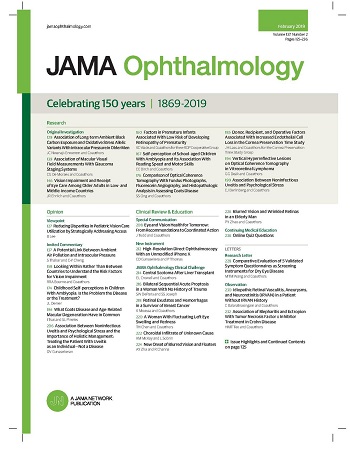从高眼压治疗研究视盘照片预测视网膜神经纤维层厚度。
IF 7.8
1区 医学
Q1 OPHTHALMOLOGY
引用次数: 0
摘要
通过视盘照片对视网膜神经纤维层(RNFL)厚度进行深度学习预测,可能有助于确定高眼压患者发生原发性开角型青光眼(POAG)的风险。目的从高眼压治疗研究(OHTS)的视盘照片中预测RNFL的平均厚度,并评估预测RNFL厚度作为POAG发展的危险因素的效用。设计、环境和参与者本诊断性研究评估了来自1636名高眼压患者的3272只眼睛,但在OHTS 1和2试验入组时没有POAG。OHTS是一项多中心研究,OHTS 1和OHTS 2从1994年2月28日持续到2008年12月30日。视盘照片、基线人口统计学和临床检查结果被纳入分析。使用oct训练的深度学习模型(机器对机器[M2M]模型)从66张 714张视盘照片中生成预测的RNFL厚度。主要结局和测量主要结局是通过比例风险模型确定的与OHTS队列转化为POAG相关的因素(包括预测的RNFL)。结果在OHTS队列的1444名高眼压患者中,平均(SD)年龄为56.0(9.5)岁,833名(57.7%)为女性。平均(SD)基线预测的RNFL在转化为POAG的眼睛为94.1 (7.1)μm,在未转化为POAG的眼睛为97.1 (7.0)μm(平均差值为3.0;95% ci, 2.2-3.8;p < 0.001)。在单变量分析的Cox比例风险模型中,预测基线RNFL是随访期间转化为POAG的预测因子(风险比[HR], 1.97;95% ci, 1.60-2.42;P < 0.001)和多变量分析(HR, 1.83;95% ci, 1.49-2.25;P < 0.001),每10 μm厚度预测RNFL。在单变量和多变量分析中,基线年龄、眼压、角膜中央厚度、模式标准差、平均偏差和杯盘比仍然是POAG转化的预测因素。预测RNFL的纵向变化(每1 μm/年更快的损失)也是POAG转化的预测因子(HR, 6.01;95% ci, 3.33-10.64;p < 0.001)。结论和相关性在本诊断研究中,基线m2m预测RNFL厚度和预测RNFL纵向变化率是高眼压患者青光眼发生的推定危险因素。这些发现支持m2m预测的RNFL厚度在评估基线青光眼风险和监测青光眼进展方面的应用。本文章由计算机程序翻译,如有差异,请以英文原文为准。
Predicting Retinal Nerve Fiber Layer Thickness From Ocular Hypertension Treatment Study Optic Disc Photographs.
Importance
Deep learning predictions of retinal nerve fiber layer (RNFL) thickness derived from optic disc photographs may help to determine risk for development of primary open-angle glaucoma (POAG) in patients with ocular hypertension.
Objective
To predict mean RNFL thickness from the optic disc photographs from the Ocular Hypertension Treatment Study (OHTS) and assess the utility of predicted RNFL thickness as a risk factor for the development of POAG.
Design, Setting, and Participants
This diagnostic study evaluated 3272 eyes from 1636 participants with ocular hypertension but without POAG at the time of enrollment in the OHTS 1 and 2 trials. The OHTS was a multicenter study, with OHTS 1 and OHTS 2 collectively extending from February 28, 1994, to December 30, 2008. Optic disc photographs, baseline demographics, and clinical examination findings were included in the analysis. An OCT-trained deep learning model (machine-to-machine [M2M] model) was used to generate predicted RNFL thicknesses from 66 714 optic disc photographs.
Main Outcomes and Measures
The primary outcomes were factors (including predicted RNFL) that correlated with conversion to POAG from the OHTS cohort, identified by proportional hazards models.
Results
Among 1444 participants with ocular hypertension from the OHTS cohort, mean (SD) age was 56.0 (9.5) years, and 833 participants (57.7%) were female. Mean (SD) baseline predicted RNFL was 94.1 (7.1) μm for eyes that converted to POAG and 97.1 (7.0) μm for eyes that did not convert to POAG (mean difference, 3.0; 95% CI, 2.2-3.8; P < .001). Predicted baseline RNFL was a predictor of conversion to POAG during follow-up in Cox proportional hazards models in univariable analysis (hazard ratio [HR], 1.97; 95% CI, 1.60-2.42; P < .001) and multivariable analysis (HR, 1.83; 95% CI, 1.49-2.25; P < .001) per 10-μm thinner in predicted RNFL. Baseline age, intraocular pressure, central corneal thickness, pattern standard deviation, mean deviation, and cup-disc ratio remained predictors of conversion to POAG in both univariable and multivariable analysis. Longitudinal change in predicted RNFL (per 1-μm/year faster loss) was also a predictor of conversion to POAG (HR, 6.01; 95% CI, 3.33-10.64; P < .001).
Conclusions and Relevance
In this diagnostic study, baseline M2M-predicted RNFL thickness and longitudinal rate of change in predicted RNFL were putative risk factors for the development of glaucoma in patients with ocular hypertension. These findings support the utility of M2M-predicted RNFL thickness to assess baseline glaucoma risk and monitor for glaucoma progression.
求助全文
通过发布文献求助,成功后即可免费获取论文全文。
去求助
来源期刊

JAMA ophthalmology
OPHTHALMOLOGY-
CiteScore
13.20
自引率
3.70%
发文量
340
期刊介绍:
JAMA Ophthalmology, with a rich history of continuous publication since 1869, stands as a distinguished international, peer-reviewed journal dedicated to ophthalmology and visual science. In 2019, the journal proudly commemorated 150 years of uninterrupted service to the field. As a member of the esteemed JAMA Network, a consortium renowned for its peer-reviewed general medical and specialty publications, JAMA Ophthalmology upholds the highest standards of excellence in disseminating cutting-edge research and insights. Join us in celebrating our legacy and advancing the frontiers of ophthalmology and visual science.
 求助内容:
求助内容: 应助结果提醒方式:
应助结果提醒方式:


